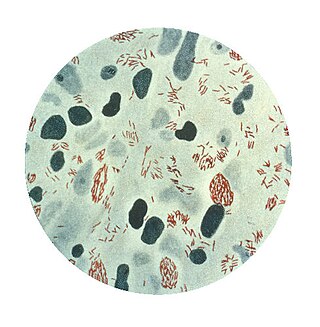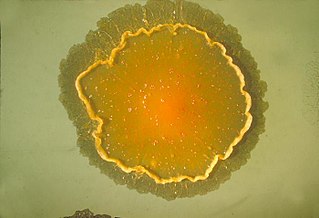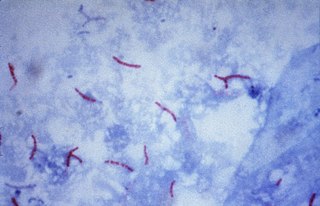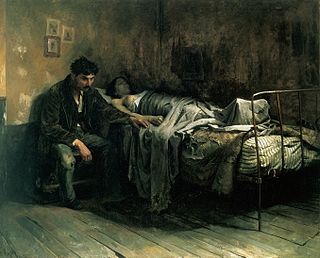
The Bacillus Calmette–Guérin (BCG) vaccine is a vaccine primarily used against tuberculosis (TB). It is named after its inventors Albert Calmette and Camille Guérin. In countries where tuberculosis or leprosy is common, one dose is recommended in healthy babies as soon after birth as possible. In areas where tuberculosis is not common, only children at high risk are typically immunized, while suspected cases of tuberculosis are individually tested for and treated. Adults who do not have tuberculosis and have not been previously immunized, but are frequently exposed, may be immunized, as well. BCG also has some effectiveness against Buruli ulcer infection and other nontuberculous mycobacterial infections. Additionally, it is sometimes used as part of the treatment of bladder cancer.

Tuberculosis (TB), also known colloquially as the "white death", or historically as consumption, is a contagious disease usually caused by Mycobacterium tuberculosis (MTB) bacteria. Tuberculosis generally affects the lungs, but it can also affect other parts of the body. Most infections show no symptoms, in which case it is known as latent tuberculosis. Around 10% of latent infections progress to active disease that, if left untreated, kill about half of those affected. Typical symptoms of active TB are chronic cough with blood-containing mucus, fever, night sweats, and weight loss. Infection of other organs can cause a wide range of symptoms.

Mycobacterium tuberculosis, also known as Koch's bacillus, is a species of pathogenic bacteria in the family Mycobacteriaceae and the causative agent of tuberculosis.

Mycobacterium is a genus of over 190 species in the phylum Actinomycetota, assigned its own family, Mycobacteriaceae. This genus includes pathogens known to cause serious diseases in mammals, including tuberculosis and leprosy in humans. The Greek prefix myco- means 'fungus', alluding to this genus' mold-like colony surfaces. Since this genus has cell walls with a waxy lipid-rich outer layer containing high concentrations of mycolic acid, acid-fast staining is used to emphasize their resistance to acids, compared to other cell types.

Mycobacterium leprae is one of the two species of bacteria that cause Hansen's disease (leprosy), a chronic but curable infectious disease that damages the peripheral nerves and targets the skin, eyes, nose, and muscles.

Isoniazid, also known as isonicotinic acid hydrazide (INH), is an antibiotic used for the treatment of tuberculosis. For active tuberculosis, it is often used together with rifampicin, pyrazinamide, and either streptomycin or ethambutol. For latent tuberculosis, it is often used alone. It may also be used for atypical types of mycobacteria, such as M. avium, M. kansasii, and M. xenopi. It is usually taken by mouth, but may be used by injection into muscle.

Mycobacterium bovis is a slow-growing aerobic bacterium and the causative agent of tuberculosis in cattle. It is related to Mycobacterium tuberculosis, the bacterium which causes tuberculosis in humans. M. bovis can jump the species barrier and cause tuberculosis-like infection in humans and other mammals.
Nontuberculous mycobacteria (NTM), also known as environmental mycobacteria, atypical mycobacteria and mycobacteria other than tuberculosis (MOTT), are mycobacteria which do not cause tuberculosis or leprosy/Hansen's disease. NTM can cause pulmonary diseases that resemble tuberculosis. Mycobacteriosis is any of these illnesses, usually meant to exclude tuberculosis. They occur in many animals, including humans, and are commonly found in soil and water.

Mycobacterium marinum is a slow growing fresh and saltwater mycobacterium (SGM) belonging to the genus Mycobacterium and the phylum Actinobacteria. It was formerly known as Mycobacterium balnei. The strain marinum was first identified by Joseph D. Aronson in 1926 and it is observed as a pathogenic mycobacterium causing tuberculosis-like infections in fish (mycobacteriosis) and skin lesions in humans. The bacteria grows optimal at a temperature around 30 °C.

Mycobacteroides abscessus is a species of rapidly growing, multidrug-resistant, nontuberculous mycobacteria (NTM) that is a common soil and water contaminant. Although M. abscessus most commonly causes chronic lung infection and skin and soft tissue infection (SSTI), it can also cause infection in almost all human organs, mostly in patients with suppressed immune systems. Amongst NTM species responsible for disease, infection caused by M. abscessus complex are more difficult to treat due to antimicrobial drug resistance.
Mycobacterium africanum is a species of Mycobacterium that is most commonly found in West African countries, where it is estimated to cause up to 40% of pulmonary tuberculosis. The symptoms of infection resemble those of M. tuberculosis.
Mycobacterium caprae is a species of bacteria in the genus Mycobacterium and a member of the Mycobacterium tuberculosis complex. The species is named after the caprines, the organisms from which M. caprae was first isolated. Prior to 2003, the species was referred to as Mycobacterium tuberculosis subsp. caprae. It is also synonymous with the name Mycobacterium bovis subsp. caprae.
Mycobacterium avium complex is a group of mycobacteria comprising Mycobacterium intracellulare and Mycobacterium avium that are commonly grouped because they infect humans together; this group, in turn, is part of the group of nontuberculous mycobacteria. These bacteria cause Mycobacterium avium-intracellulare infections or Mycobacterium avium complex infections in humans. These bacteria are common and are found in fresh and salt water, in household dust and in soil. MAC bacteria usually cause infection in those who are immunocompromised or those with severe lung disease.

Mycobacterium kansasii is a bacterium in the Mycobacterium genus. It is an environmental bacteria that causes opportunistic infections in humans, and is one of the leading mycobacterial causes of human disease after tuberculosis and leprosy.
Mycobacterium microti is a member of the Mycobacterium tuberculosis complex (MTBC) known as the 'Vole bacillus', first described as a pathogen of field voles in England.
Mycobacterium canettii, a novel pathogenic taxon of the Mycobacterium tuberculosis complex (MTBC), was first reported in 1969 by the French microbiologist Georges Canetti, for whom the organism has been named. It formed smooth and shiny colonies, which is highly exceptional for the MTBC. It was described in detail in 1997 on the isolation of a new strain from a 2-year-old Somali patient with lymphadenitis. It did not differ from Mycobacterium tuberculosis in the biochemical tests and in its 16S rRNA sequence. It had shorter generation time than clinical isolates of M. tuberculosis and presented a unique, characteristic phenolic glycolipid and lipo-oligosaccharide. In 1998, Pfyffer described abdominal lymphatic TB in a 56-year-old Swiss man with HIV infection who lived in Kenya. Tuberculosis caused by M. canettii appears to be an emerging disease in the Horn of Africa. A history of a stay to the region should induce the clinician to consider this organism promptly even if the clinical features of TB caused by M. canettii are not specific. The natural reservoir, host range, and mode of transmission of the organism are still unknown.

Multidrug-resistant tuberculosis (MDR-TB) is a form of tuberculosis (TB) infection caused by bacteria that are resistant to treatment with at least two of the most powerful first-line anti-TB medications (drugs): isoniazid and rifampicin. Some forms of TB are also resistant to second-line medications, and are called extensively drug-resistant TB (XDR-TB).

The history of tuberculosis encompasses the origins of the disease, tuberculosis (TB) through to the vaccines and treatments methods developed to contain and mitigate its impact.
The Mycobacterium tuberculosis complex is a genetically related group of Mycobacterium species that can cause tuberculosis in humans or other animals.
Kirsten Bos is a Canadian physical anthropologist. She is Group Leader of Molecular Palaeopathology at the Max Planck Institute for Evolutionary Anthropology in Leipzig. Her research focuses on ancient DNA and infectious diseases.










